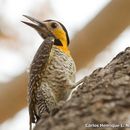Biology
(
Inglês
)
fornecido por Arkive
When Charles Darwin observed the campo flicker in Maldonado, Uruguay, he was struck by the fact that, while it had all the physical features seen in related woodpecker species, it did not occupy trees, and instead built its nest in mud banks. This observation was used to support the theory that significant changes in behaviour could give rise to new species. However, another naturalist who had observed the campo flicker nesting in tree holes accused Darwin of falsifying evidence to support his theory of evolution (3). Today, it is known that in wooded regions, the campo flicker nests in trees, while in treeless areas, it will nest in mud banks (2) (3). Other nesting sites may also include telephone poles, dead stumps and termite mounds. Nesting takes place between January and April in Surinam and from August to November in Argentina. The nests are excavated using the bill-hammering technique commonly exhibited by woodpeckers, and once prepared, a clutch of four to five eggs is laid within the cavity, and incubated by both parent birds (2).
The campo flicker mainly feeds on ants and termites, consuming large amounts, which is evidenced by a record of over 2000 ants found in the stomach of one individual. Beetles, grasshoppers and nestlings are also taken (2), as well as fruit (4). Foraging generally occurs in small groups, which are often found clustered around an anthill. Most prey is located while walking along the ground, by searching amongst stones, in decaying fallen logs, or on roads. Occasionally, however, foraging also takes place in isolated trees, on cacti and fence poles (2).
Conservation
(
Inglês
)
fornecido por Arkive
While there are currently no specific conservation measures in place for the campo flicker (1), it is found in several protected areas (2).
Description
(
Inglês
)
fornecido por Arkive
A striking variety of woodpecker, the campo flicker can be identified by the bold colouration of the head and neck, and the conspicuous patterning of the body. The crown of the head and nape of the neck are black, while the sides of the head, neck and upper breast are golden. The upperparts are dark brown with narrow, light brown and whitish bars, while the underparts and rump are white with narrow, dark barring and sometimes with dark spots as well. The bill is reasonably long and pointed, the eye is chestnut to red-brown and the legs are green-grey or tinged with pink. There are two recognised subspecies of the campo flicker which differ in the colouration of the chin and throat, black in Colaptes campestris campestris, and whitish yellow in Colaptes campestris campestroides. The sexes also differ in appearance, with the male possessing a reddish patch at the end of a black stripe extending from the base of the bill, which is lacking in the female. (2).
Habitat
(
Inglês
)
fornecido por Arkive
The campo flicker generally inhabits open habitats such as savanna, grassland, farmland and scrubland. Woodland edges may also be occupied, as well as forest clearings, overgrazed land and undeveloped areas bordering highways (2).
Range
(
Inglês
)
fornecido por Arkive
The campo flicker has a relatively large distribution, with subspecies Colaptes campestris campestris occupying southern Surinam and north-central and eastern Brazil, west to northern and eastern Bolivia and central Paraguay. Colaptes campestris campestroides occurs to the south of this range, in central and southern Paraguay, south-east Brazil, Uruguay, and north-east and eastern Argentina (2).
Status
(
Inglês
)
fornecido por Arkive
Classified as Least Concern (LC) on the IUCN Red List (1).
Threats
(
Inglês
)
fornecido por Arkive
There are currently no major threats to the campo flicker's survival (1). Indeed, unlike most species, the campo flicker is actually benefitting from forest clearance, especially for road building, as the resulting areas of open habitat that are created alongside the new highways are favoured by this species (2).

